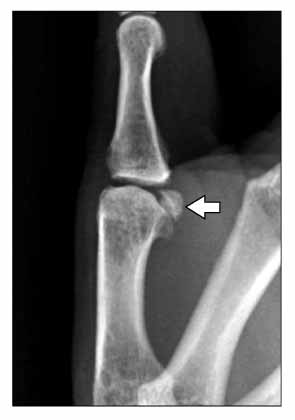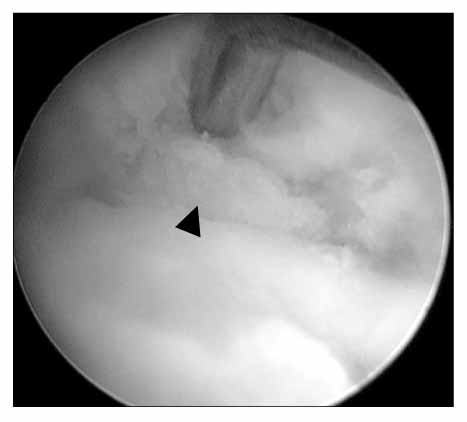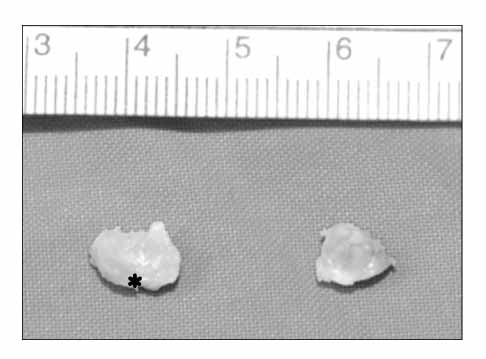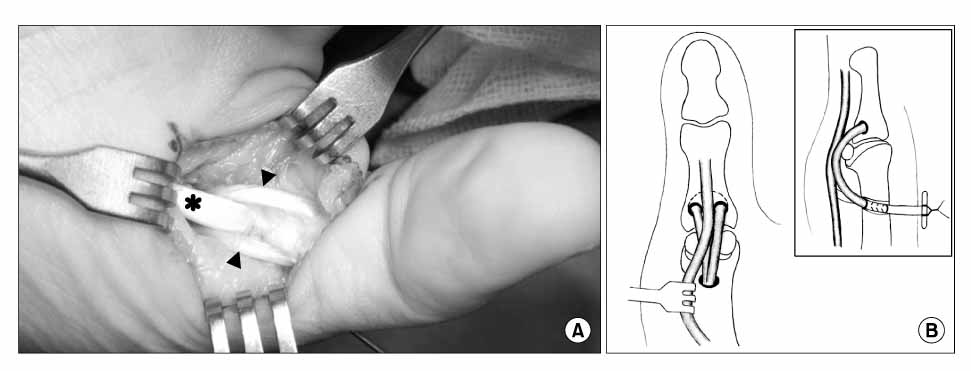J Korean Orthop Assoc.
2009 Apr;44(2):240-248.
Treatment of Subsesamoid Arthritis of the Metacarpophalangeal Joint of the Thumb: Volar Plate Reinforcing Technique after Sesamoid Excision
- Affiliations
-
- 1Department of Orthopaedic Surgery, Dankook University College of Medicine, Cheonan, Korea. kimjp@dankook.ac.kr
Abstract
- PURPOSE
To report the clinical outcomes of a volar plate reinforcing technique with free tendon grafts after sesamoid excision for the surgical treatment of subsesamoid arthritis of the metacarpophalangeal (MCP) joint of the thumb. MATERIALS AND METHODS: Eleven consecutive patients that underwent sesamoid excision and volar plate reinforcement using a palmaris longus free tendon graft were enrolled. There were 7 males and 4 females, with an average age of 46 (range, 30-56 years). Post-traumatic arthritis after a hyperextension injury of the thumb was present in 9 patients. Two patients had idiopathic arthritis. All patients were evaluated by objective and subjective criteria, the mean follow-up duration was 19 months (range, 12-35 months). RESULTS: The results were satisfactory overall (3 excellent, 7 good, 1 poor). The mean grip strength and pinch strength significantly improved from 63.0% and 51.3%, respectively, preoperatively, to 84.9% and 88.9%, postoperatively. The mean range of motion for the MCP joint was -5.9/50.9 degrees. The mean DASH and MHQ scores showed significant improvement compared to the preoperative scores. CONCLUSION: The early clinical results suggest that the described technique is a safe and effective option for subsesamoid arthritis of the MCP joint of the thumb.
Keyword
MeSH Terms
Figure
Reference
-
1. Chung KC, Pillsbury MS, Walters MR, Hayward RA. Reliability and validity testing of the Michigan Hand Outcomes Questionnaire. J Hand Surg Am. 1998. 23:575–587.
Article2. Eiken O. Palmaris longus-tenodesis for hyperextension of the thumb metacarpophalangeal joint. Scand J Plast Reconstr Surg. 1981. 15:149–152.
Article3. Glickel SZ. Peimer CA, editor. Metacarphophalangeal and interphalangeal joint injuries and instabilities. Surgery of the hand and upper extremity. 1996. v. 1-2. New York: McGraw-Hill;1043–1068.4. Glickel SZ, Malerich M, Pearce SM, Littler JW. Ligament replacement for chronic instability of the ulnar collateral ligament of the metacarpophalangeal joint of the thumb. J Hand Surg Am. 1993. 18:930–941.
Article5. Hudak PL, Amadio PC, Bombardier C. Development of an upper extremity outcome measure: the DASH (disabilities of the arm, shoulder and hand) [corrected]. The Upper Extremity Collaborative Group (UECG). Am J Ind Med. 1996. 29:602–608.6. Kessler I. A simplified technique to correct hyperextension deformity of the metacarpophalangeal joint of the thumb. J Bone Joint Surg Am. 1979. 61:903–905.
Article7. Masson JA, Golimbu CN, Grossman JA. MR imaging of the metacarpophalangeal joints. Magn Reson Imaging Clin N Am. 1995. 3:313–325.
Article8. Mohler LR, Trumble TE. Disorders of the thumb sesamoids. Hand Clin. 2001. 17:291–301.
Article9. Parks BJ, Hamlin C. Chronic sesamoiditis of the thumb: pathomechanics and treatment. J Hand Surg Am. 1986. 11:237–240.
Article10. Posner MA, Langa V, Ambrose L. Intrinsic muscle advancement to treat chronic palmar instability of the metacarpophalangeal joint of the thumb. J Hand Surg Am. 1988. 13:110–115.
Article11. Rozmaryn LM, Wei N. Metacarpophalangeal arthroscopy. Arthroscopy. 1999. 15:333–337.
Article12. Schuurman AH, Bos KE. Treatment of volar instability of the metacarpophalangeal joint of the thumb by volar capsulodesis. J Hand Surg Br. 1993. 18:346–349.
Article13. Seybold EA, Warhold LG. Impingement of the flexor pollicis longus tendon by an enlarged radial sesamoid causing trigger thumb: a case report. J Hand Surg Am. 1996. 21:619–620.14. Trumble TE, Watson HK. Posttraumatic sesamoid arthritis of the metacarpophalangeal joint of the thumb. J Hand Surg Am. 1985. 10:94–100.
Article15. Zancolli EA. Claw-hand caused by paralysis of the intrinsic muscles: a simple surgical procedure for its correction. J Bone Joint Surg Am. 1957. 39:1076–1080.
- Full Text Links
- Actions
-
Cited
- CITED
-
- Close
- Share
- Similar articles
-
- Posttraumatic Chronic Volar Instability of the Thumb Metacarpophalangeal Joint
- Sesamoid arthritis with locked metacarpophalangeal joint misdiagnosed as trigger finger: a case report
- Dislocation of the Metacarpophalangeal Joint Hand: Report of Three Cases
- Locking of the Metacarpophalangeal Joint of the Thumb: Report of Two Cases and an Anatomic Study of the Heads of the First Metacarpals
- Roentgenologic study of sesamoid bones







